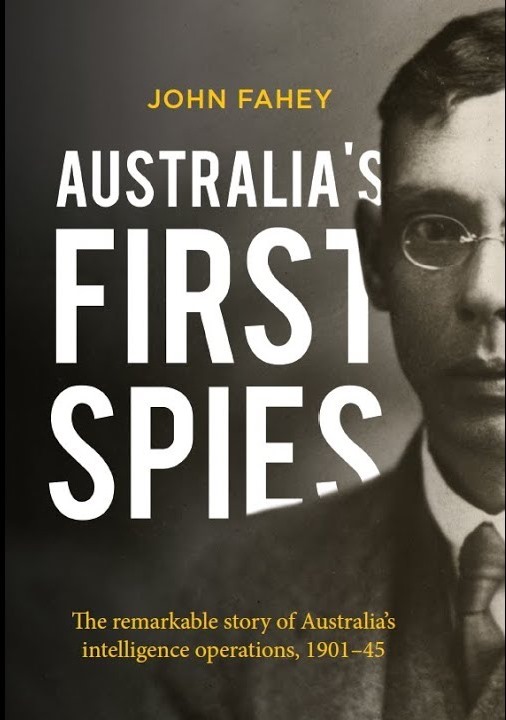This impressively researched book deals with the origins and development of Australia’s intelligence services from Federation to 1945. As well as covering the better-known organisations and their work, Dr Fahey reveals the birth of Australia’s political intelligence capabilities – initially directed at the French and British
in the Pacific – and the intriguing ‘Wanetta’ Organisation.

Ursula Davidson Library call number 411.7 FAHE 2018
Operating under the cover of a legitimate pearling company, its luggers ranged freely throughout the Netherlands East Indies reporting on the activities of German agents during World War I.Dr Fahey’s research provides greater depth to our knowledge and understanding of the efforts of Australia’s navy and army to develop and refine their capabilities in human intelligence and the new art and science of signals intelligence during and post-World War I. Early successes are chronicled, including the breaking of German codes by the Navy and the shaky start to the Royal Australian Navy’s Coast Watcher Service, along with failures as Australia struggled with a distinct lack of central guidance which might have created a national intelligence capability before World War II. The problem was not confined to this country as the story of wasteful United States inter-service rivalry and intransigence throughout the war demonstrates.
The energetic and resourceful empire-building Director of Naval Intelligence, Commander Rupert Long, proved to be one of the pivots towards better coordination and development of Australian service intelligence capabilities and of co-ordination with our Allies. The development of Army capabilities from a slow start are highlighted, as is the awakening of Royal Australian Air Force interest in the field. However, Dr Fahey is commendably forthright in dismissing the claims of the Services Reconnaissance Department of General MacArthur’s Allied Intelligence Bureau to any meaningful contribution to the war effort in the South West Pacific Area. In short, the Japanese ran rings around them.
It comes as little surprise that Australia’s political intelligence agencies and politicians themselves proved inept in protecting classified information during World War II. Even parts of the Allied military hierarchy had similar difficulties – General MacArthur was a principal offender in releasing the precious ULTRA information indiscriminately. The system for using signals intelligence in ways that would not reveal to the enemy that their codes had been compromised was not standardised amongst the Allies until 1943, and these rules led to ULTRA being denied to Australian political leaders and government departments. This lax attitude towards keeping Allied secrets secret was to have ramifications for the nation immediately following the end of the war.
Some of Dr Fahey’s conclusions are open to discussion. Navy, with its Coast Watchers in place, its sponsorship of codebreaking through the Special Intelligence Bureau from 1941 and its leadership of the Combined Operations Intelligence Centre was hardly ‘unprepared’ for hostilities. The only game in town until the Army got itself organised, the claim that Navy ‘picked the wrong horse’ in throwing its lot in with the United States Navy-dominated FRUMEL ignores the fact that in early 1942 there was no other organisation with which it could co-operate. Navy also supported the formation of MacArthur’s United States Army-dominated Central Bureau from July 1942 in Brisbane, but FRUMEL’s early successes against Japanese advances in the period May-July 1942 were crucial to the course of the war. Central Bureau’s days of glory came later, from 1944 onwards.
The narrative seems to end quite abruptly. It would have been useful had the author provided a short chapter describing the dissolution of the Allied intelligence organisations in 1945 and the establishment of the Australian Defence Signals Bureau in 1947. This might also have included a brief description of Australian accession to the ‘Five Eyes’ signals intelligence arrangements resulting from the development of our national capabilities and contributions throughout World War II. This information is buried in Chapter 21 within a discussion of the role of Australian Lieutenant Colonel ‘Mick’ Sanford of Central Bureau in negotiations with the British, but he was far from the only actor in this important turning point in Australian intelligence history.
I have difficulty with the book’s title. Most of the activities described in it are not in the nature of espionage. Exploiting information freely provided by an organisation of interest through electro-magnetic emissions is intelligence collection – just as your favourite Web browser exploits information you provide when you log on and your local supermarket collects information on you when you swipe their loyalty card. This isn’t ‘spying’, but the word ‘Spies’ quite possibly might generate more sales of Dr Fahey’s otherwise excellent work.
I commend it to lay people and professionals alike.
Contact Ian Pfennigwerth about this article.






